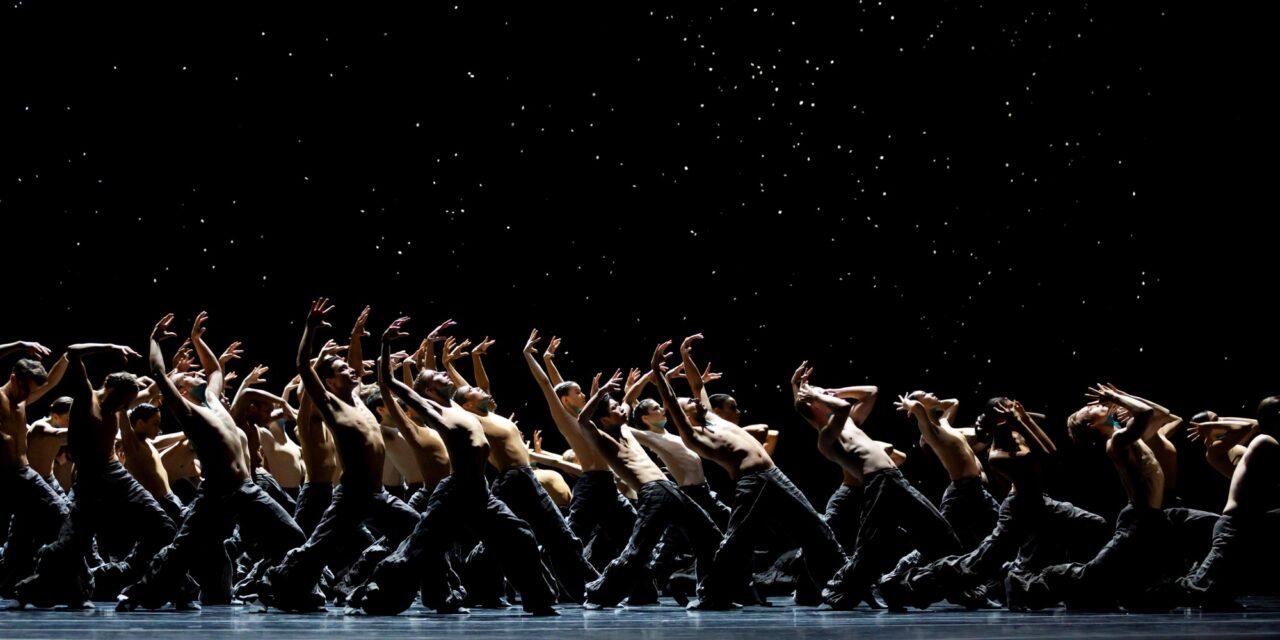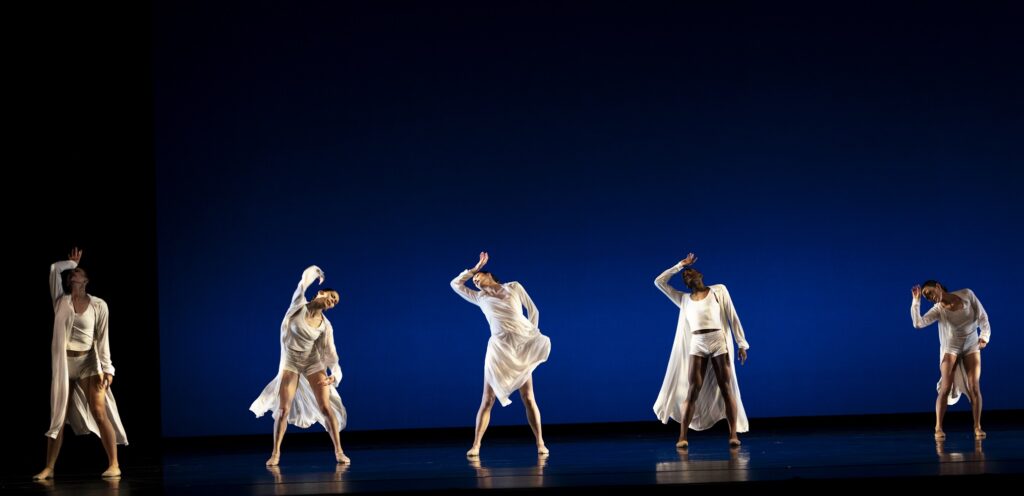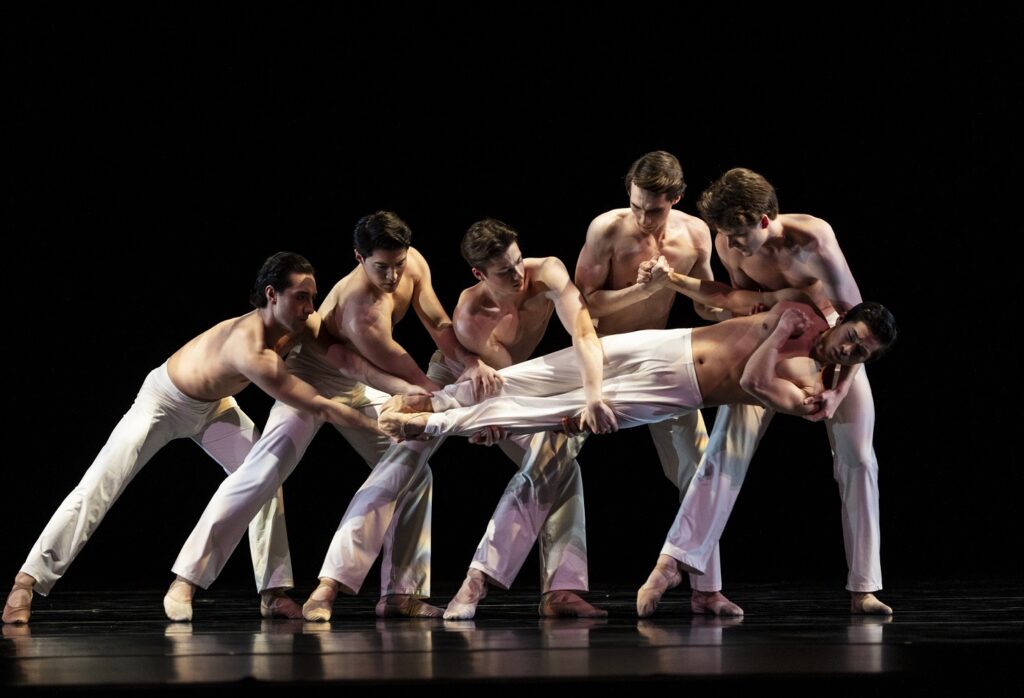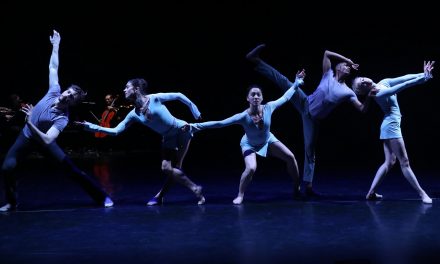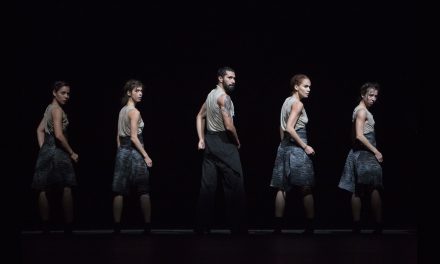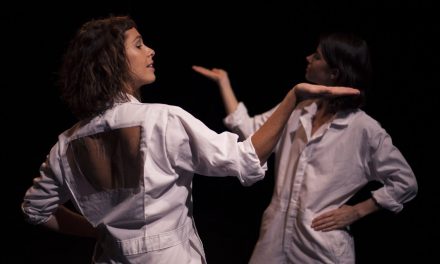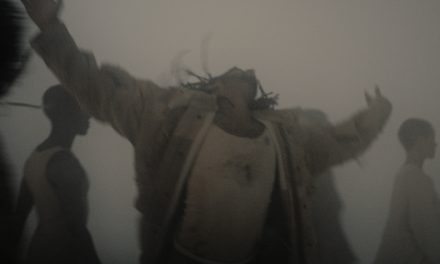Pacific Northwest Ballet’s, “The Seasons’ Canon”, returned by popular demand on April 19-29, 2024 under the astute leadership of Artistic Director, Peter Boal and Executive Director, Ellen Walker. Its return says much, since it is an exceptional evening of artistic and spiritual perfection by three female choreographers and their brilliant work; Twyla Tharp’s Shaker-inspired “Sweet Fields,” Jessica Lang’s deeply impassioned solo piece “The Calling,” and the stunning primordial “The Seasons’ Canon” by Crystal Pite. Each, so reverent, moving and brilliant in their view of life and death by artists that honor their craft, create space for cognition, present true depth of feeling, and all while requiring outstanding technical mastery from PNB’s world class company. Those elements, in our time, are not only commendable, but vital.
Canon is defined as “the theme of a fundamental truth or …a foundation for a system of belief, behavior, or chain of reasoning.”
Tharp’s, “Sweet Fields,” reaches into her early roots to explore the Shaker’s expression of movement and song. The power is in its beautifully crafted simplicity and emotional depiction of the best of the faithful. Tharp based “Sweet Fields” on early traditional vocal music by William Billings (1746-1800), considered the first American Composer; William Walker (1809-1875) known as the composer of “Amazing Grace” and author of American Southern Harmony (ASH); Abraham Wood (1752 – 1804) an early American composer who wrote A Hymn of Peace” and died at the battle of Bunker Hill; and Jeremiah Ingalls (1764-1838), was part of the First New England School of Music.
Simple truths beautifully sung in four-voice homophonic textures by the Tudor Choir, and conducted by Doug Fullington, with dancers: Melisa Guilliams, Juliet Prine, Lily Wills, Clara Ruf Maldonado, Ashton Edward, Yuki Takahashi, Luther DeMyer, Christian Poppe, Luca Anaya, Mark Cuddihee, Dylan Calahan, and Kuu Sakuragi gives a liveness and immediacy to this joyous piece of faith and tradition. The dancer’s excellence and the earthy movements of the hard-working faithful show the traditional separation of men from women in the 1700’s. Throughout the piece a recurring homage to the Shaker movements brings new life and invention to this period. Tharp’s use of fugue’s connects her work to the early American composers who have become a staple of American Christian Musical life. Inspired by her own Quaker upbringing, Tharp reflected on the hymns of the past, primarily English and Celtic, with reels, hornpipes, jigs, and minuets that gave lilting traditions to the quality of the piece.
“Sweet Fields” begins with men in white flowing shirts and simple trousers entering the space thru a low-lit fog, as if coming from the past. Moving in stylized lunges and walks they turn slowly exploring the configurations and reconfigurations of patterns so well mapped by Tharp. Women are then introduced with a joyous celebration of their own life and work. Costumed also in white, they wear T tops and shorts with silk long-coats that move with each breath. Norma Kamali’s designs add to the effortless and engaging movements.
The dancer’s freedom and joy soon fades into the darkness, leaving a pathway for a dirge. A line of men walk slowly, deliberately, carrying a body overhead. Slow lunges…a sudden spin and drop from overhead…and the body is soon replaced by another, all with long legato movements that finally end as the lights fade to dark.
Next are the male dancers who delight in doing the entire movement by running with quick steps, moving backwards, “we skip and play.” Then comes a lilting Shaker’s dance placing male and females into groups, skipping and walking as the soloist, Ashton Edwards gathers the company in a simple Hop step, point, point. Edwards finally does a continuous spin, traveling through the entire group, as they come together in the unity of a circle. And as the music stops they keep dancing, making way for the next piece which honors and uses William Walker’s famed verbal and shape-recognition music technique to construct the dance piece. William Walker’s technique “La, sol, fa – la sol, sol” and the dancers as a group use lyrics of his joyous song of “happy days…adorn his shining grace.’ They swing and lift in their exuberance that “death itself shall die.” As the entire company fades with its lovely use of effortless movement to end this canon of faith.
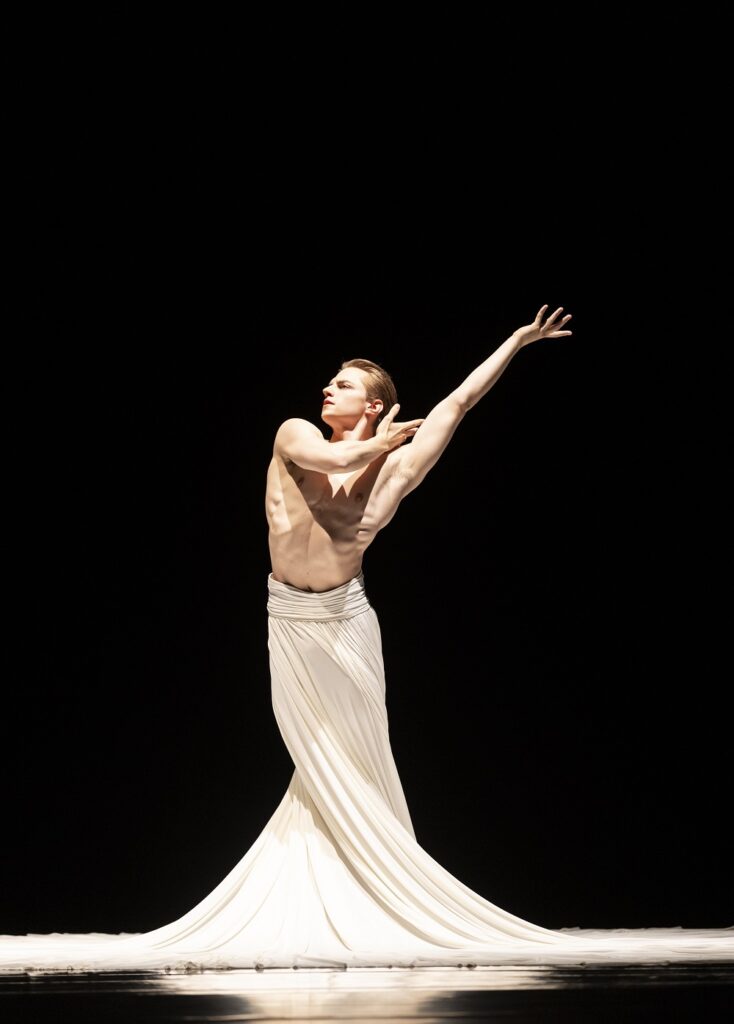
Pacific Northwest Ballet principal dancer Dylan Wald in Jessica Lang’s “The Calling” – Photo © Angela Sterling.
After a short intermission, the second piece, “The calling,” created by PNB’s new resident choreographer Jessica Lang had its stunning premiere. She used music from the 12th century, “O Maria, Stella Maris,” sung over low droning sounds, supporting the warm tones of vocal soloist, Christina Siemens. This remarkable piece takes the audience to another time and space. Lang’s piece is a kind of honoring of her mentor Benjamin Harkarvy (Juilliard), whose sage wisdom lives after him in “The Calling.”
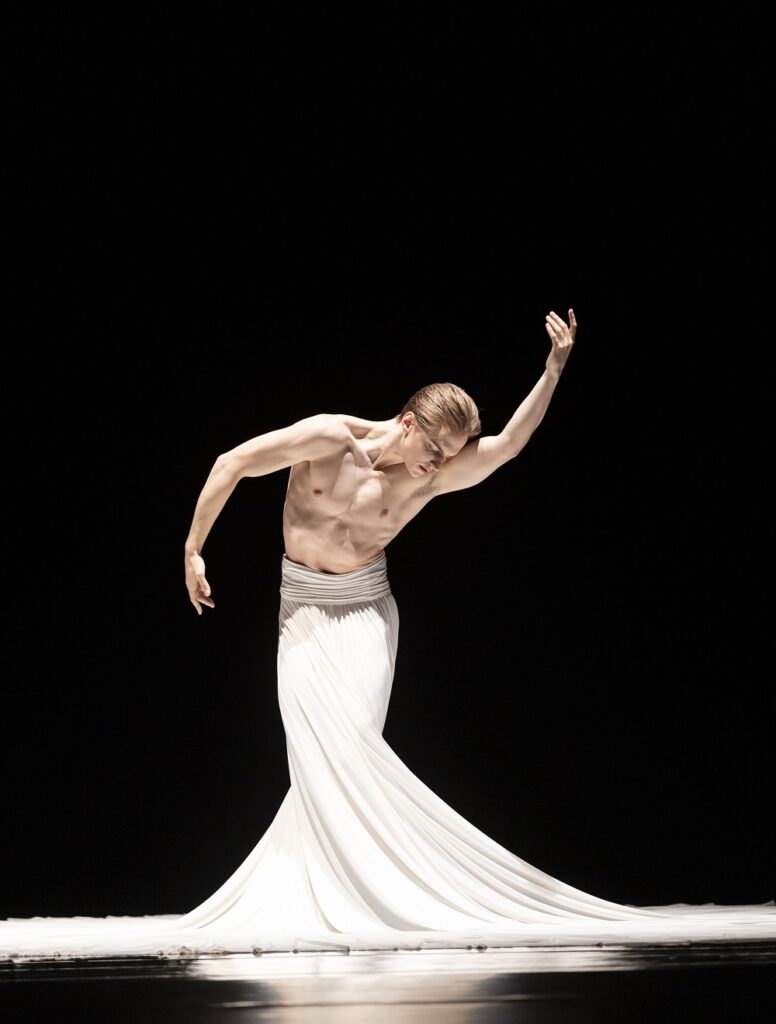
Pacific Northwest Ballet principal dancer Dylan Wald in Jessica Lang’s “The Calling” – Photo © Angela Sterling.
The lights slowly reveal the aesthetic form of Dylan Wald and presents a mood and art that touches the spirit with the majesty of prayer. So beautifully staged by Kanji Segawa, the spectacular dramatic lighting design by Nicole Pearce partners with Lang’s moving and artful sensitivity and holds one in suspension with each legato twist and turn. Wald’s sensual unhurried extended movements unfurl the periphery of the classic skirt flowing from his hips, designed by Elena Comendador. His body unexpectedly creates patterns that eventually allow him to descend onto his back on the ground appearing to defy gravity, then rising as though ascending from the dead. This ‘prayer’ helps to realize the wisdom of truly aesthetic work that remains unforgettable through time and is an excellent addition to this very special evening for Lang.
And finally, Crystal Pite’s profound exploration of “The Seasons’ Canon” is an awakening not only of dance but of life. It is transformational. The choice of her artistic team; Max Richter’s brilliant, recomposed music of Vivaldi’s The Seasons with Scenic Design/Reflected Light Concept by Jay Gower Taylor & Tom Visser and Lighting Design by Visser and Douwe Beernink, Costume Design by Nancy Bryant, with Staging by Eric Beauchesne, performed by the amazing PNB Company with Emil de Cou, Conductor – PNB Orchestra, is a revolution in this deeply brilliant work of art.
Pite’s work reveals not only her intelligence in movement but her ability to articulate her mission:
“It is the act of making that sharpens my awareness and connects me most deeply to the natural world and all the brutality and beauty it contains. “The Seasons’ Canon” is a gesture, an offering. It is as much my way of coping with the vastness and complexity of the natural world as it is a way of giving thanks for it.” (Crystal Pite)
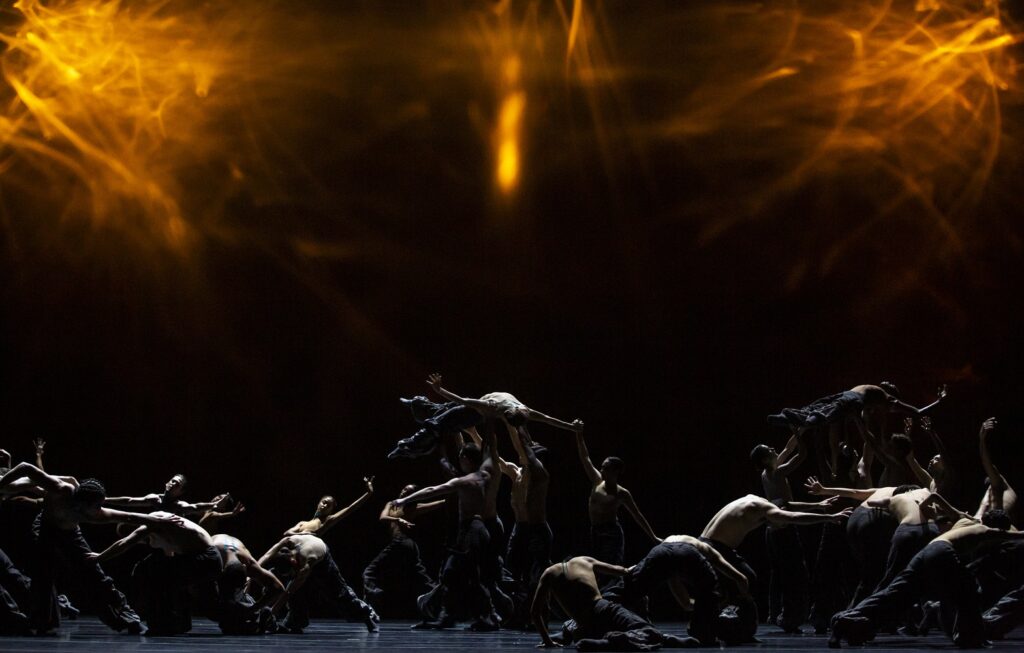
Pacific Northwest Ballet company dancers in Crystal Pite’s “The Seasons’ Canon” – Photo © Angela Sterling.
SPRING begins with swirling rivers of light reflected in the black space. It visually announces the vernal equinox slowly growing in intensity and color. Then an enigma of 54 bodies begin to quake, creating mystery and life forms of “awesome” wonder. Waves of individual arms, then sudden unison, then heads popping like nascent birds stirring, prompting arousal. Then it recedes as a singular form, (Clara Ruf Maldonado) left alone, begins the visual story as she moves away and then attempts to find her way back. Effortless lifts and reconfigurations, present unearthly universal themes of unity and separation.
Summer brings coupling and love that easily melds into an effortless pas de deux by Angelica Generosa and James Yoichi Moore appearing to transcend gravity. Their facile ardor soon turns, and with stunning clashes Leah Terada and Lucien Postlewaite easily fly into a struggle as they defy their weightlessness and strength and are soon challenged by Amanda Morgan in a clash of power. As one moment falls into another, the group goes from frenetic to lyrical as they slowly attempt, with angular arms, to take flight. The artistry of the moment emotionally takes one by surprise.
Led by Kyle Davis and Noah Martzall, the power of warriors, readying for battle brings on the Autumn winds with men lifting men, running, sliding, and making ready for battle and fighting the surging winds of Fall.
With expand and contract and like snow crystals, a line of arms make patterns that nearly take one’s breath away as bodies lean and roll while lights fade. A woman is revealed, standing, overlooking the group. Lifted, she walks as they support her. The strains of the solo violin (Michael Jinsoo Lim) guide the dancers as if in a dream. She climbs the stairway of bodies as they slowly rise. Snow begins to fall and the sense of endings is clear with artful brilliance. What Pite did to pull together music, dance and design, I must repeat, is transcendent!
Thanks to Peter Boal and Ellen Walker’s artful leadership, they have not only built, but inspired a company of powerful diverse choreographers, dancers, designers, composers and musicians; while encouraging the support of benefactors and communities of dance lovers and followers, making PNB one of the most exciting artistic hubs of superlative work today.
For more information about Pacific Northwest Ballet, please visit their website.
Excerpt from Crystal Pite’s “The Seasons’ Canon”
Written by Joanne DiVito for LA Dance Chronicle.
Featured image: Pacific Northwest Ballet company dancers in Crystal Pite’s “The Seasons’ Canon” – Photo © Angela Sterling.

